Hand Osteoarthritis
On this page
- What Is Osteoarthritis Of The Hand?
- What Are The Symptoms Of Osteoarthritis Of The Hands?
- How Common Is It?
- What Causes It?
- What Can Help With Osteoarthritis Of The Hands
- Exercise
- Splints And Supports
- When To Speak To A Health Professional
- Help and Support
- Printable Version
Additional Information
- Pain Relief
- What do I do if my symptoms flare up?
- Mental Well Being
- Active Health Programme
- Staying in work and returning to work
- Smoking
- Chronic Pain
Related pages
Information about Hand Osteoarthritis
What Is Osteoarthritis Of The Hand?
Osteoarthritis (OA) is a joint condition where there is decline of the joint cartilage and the bones next to the cartilage.
The end of the bones in a joint are covered in protective cartilage. This cushions and allows for smooth movement of the joint. The joint is lubricated and nourished by synovial fluid. In OA, the body is not as efficient at repairing the cartilage and there can be joint swelling due to excess synovial fluid. Bony growths may develop next to the joint. Pain and stiffness might result in a reduced use of the joint, causing a weakening of the surrounding muscles.
OA in the hand mainly affects the base of the thumb and the small joints of the fingers.
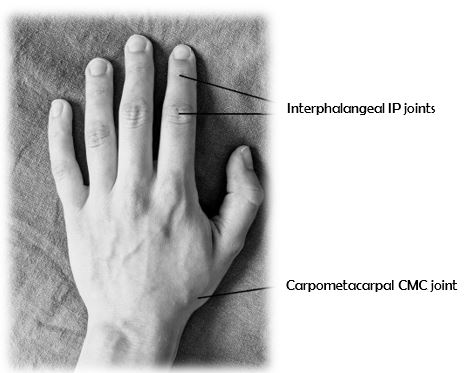
What Are The Symptoms Of Osteoarthritis Of The Hands?
- Pain: Mainly on movements or activity. Normally reduces at rest. Sharp or aching pain.
- Stiffness and reduced range of motion: Stiffness mainly following rest. Can be difficult to open thumb away from hand if the thumb CMC joint is affected.
- Tenderness if you press the affected joint.
- Difficulty with tasks and reduced grip strength: can be difficult to grip or pick up objects.
- Swelling of the affected joint.
- Deformity in advanced OA: The affected joint might look bigger and there may be changes in the posture of the CMC joints. Bony nodules on the affected finger joints may develop.
How Common Is It?
The hand is one of the most common joints affected by osteoarthritis.
The effects tend to worsen as we get older. It is much more common in women, especially after the age of 55. However, after the age of 70 both males and females are more equally affected.
What Causes It?
The hand joints are exposed to a constant low level of trauma in our everyday life and our joints go through a repair process. The joints go through this ‘wear and repair’ process also in OA. In some cases, the repair process does not manage to fully compensate for the wear, eventually leading to a symptomatic presentation of OA.
There is not a known specific cause for OA. However, several causes can play a role in the development of hand OA. These include:
- Age: The prevalence of OA increases with age
- Gender: More common in women than men
- Genetics: The tendency to develop OA may be inherited
- Previous joint injuries, abnormalities or hand surgery
- Overuse of joint (e.g. occupation): Repetitive pinch-type activities and strong grip activities can place high loads through the joints.
What Can Help With Osteoarthritis Of The Hands
It is important to remember that many adjustments and treatments can help relieve some of your symptoms. OA doesn’t always worsen through time and there are things that you can try to help your symptoms.
Research supports a mixture of treatments including:
- Exercise
- Medication
- Use of heat or cold
- Supports/splints
- Advice on self-management
There is more information below:
Helpful Tips
- Spread activities or jobs over a day or a week, especially if a lot of gripping or repetition is required.
- Consider spreading loads/activities to other joints e.g. using two hands instead of one, switching hands.
- Take notice of any increase in pain that you feel during/after an activity – is there anything you could have done to help to reduce this?
- Consider Pacing and Spacing and the Pain Activity Ladder
- Use labour-saving gadgets or devices where possible. E.g. in the kitchen, at work, gardening. Anything that makes it easier will help. Occupational therapy can help with advice.
- North Lanarkshire: https://www.makinglifeeasier.org.uk/
- South Lanarkshire: http://www.careinfoscotland.scot/topics/care-at-home/equipment-and-adaptionstelecare/
- Make sure that tools/equipment at work or for your hobbies are properly maintained i.e. oiled or sharpened.
- Avoid actions that take or push your joints into awkward positions.
- If an activity causes you difficulties, stop and think if there might be an easier way of doing it next time.
- Arthritis UK have produced a guide with more information on how to look after your joints: https://www.versusarthritis.org/about-arthritis/managing-symptoms/joint-care/
- If you have problems with activities at work, it may be helpful to ask for a workstation/workplace assessment or talk with your manager or Occupational Health Department. This can help with alterations or provision of equipment or altering your working day or tasks.
Timescales/ Prognosis
- It is worth noting that the symptoms experienced and the changes seen on an X-ray often do not match.
- OA will NOT always get worse through time.
Exercise
- If you are in pain, you may be worried about moving your joints and muscles in case you make your symptoms worse. Resting may feel better at first but too much rest will likely increase stiffness, weakness and pain levels.
- Remember that joints and muscles are designed to move.
- Taking adequate pain relief or using hot or cold packs may help to get you going at first.
- Exercise will reduce stiffness, help your pain and keep the muscles around your joints stronger.
- An exercise program is usually advised involving both stretching and strengthening.
- Exercise aims to maintain or improve joint mobility, strength and the overall use of your hand.
- A certain amount of discomfort may be expected when carrying out exercises but it is important not to push into too much pain. Start gradually and build up slowly (Remember the Pain Activity Ladder below)
- Remember to pace yourself. It can be tempting to do too much on ‘good’ days but this can make your pain worse later.
Videos of Exercises
- Video 1: Early Finger Movement https://youtu.be/nJXOFPBnG-g
- Video 2: Early Finger Movement https://youtu.be/IPNXgo3BaoY
- Video 3: Early Finger Movement https://youtu.be/c1BJ7-0gArY
- Video 4: Early Finger Movement https://youtu.be/sAl1mJdhM5k
- Video 5: Early Thumb Movement https://youtu.be/WFm1tbRTc7A
- Video 6: Early Thumb Movement https://youtu.be/mUuJNK4rwLs
- Video 7: Early Thumb Movement https://youtu.be/pfqrI-G9kWQ
- Video 8: Middle Grip Strengthening https://youtu.be/0huHMf3d7Ro
- Video 9: Middle Thumb Strengthening https://youtu.be/bcFq3lWsleI
Pain Activity Ladder
By following the pain activity ladder you can identify activities that you would consider severely painful, moderately painful and mildly irritating and act to change your habits.
The pain scale, most often used in healthcare, measures pain from 0-10 (zero being no pain and 10 representing the worst pain you could imagine).
If you can identify the level of pain you are experiencing, you will find out if you are in the green, amber or red zone. The best way to move down to the green zone is by pacing and spacing your activity.
When you are completing your rehabilitation exercises it is often best to work within the green (and sometimes amber zones depending on what you deem is an acceptable level of pain) both during the exercises and within 48 hours of completing your exercises. If you find yourself in the red zone you are likely pushing yourself too hard and may flare up the pain.
Pacing and Spacing
Pacing and spacing methods can help you manage your pain better.
Pacing is the term used for breaking down an activity or task. This can be done by taking regular breaks. Prioritising daily activities can also help. This can prevent “over stimulating” your pain system.
When completing challenging tasks or activities, it may be useful to set a “baseline”. This is the amount you can manage on a good or bad day without increasing your symptoms. Therefore, you can plan rests and set achievable goals.
Splints And Supports
- Splints and supports may be helpful along with other treatments.
- They can include supports for the fingers, thumb and wrist.
- They aim to reduce pain and stress through the joints, and improve stability and support. This can help reduce swelling and improve the function of your hand.
- They can be ‘off the shelf’ or made to fit you by an Occupational Therapist, Physiotherapist or Orthotist.
- Other supports can include compression gloves and silicon tubes for the fingers.
- It is recommended that you talk with a relevant Health Professional for the assessment and provision of these items. They will also be able to advise you on the best way to use them.
- Alternatively here you can follow these instructions on how to measure and purchase Wrist Splints and Thumb Spicas
Wrist Splints
This leaflet gives some simple advice on buying a wrist support.
The examples in this leaflet are suggestions and will give you an idea of what a wrist splint should look like. These splints cost around £10-£15 for one splint.
Does it have to be a certain design?
Your wrist splint should have a metal bar in them to limit wrist movement. It should not limit your thumb or finger movement.
If you are going to use your splint to treat Carpal Tunnel Syndrome, you should flatten the bar of the splint. This reduces the pressure on the nerve at the wrist.
Flatten the splint by placing the splint on the edge of a table and gently pushing the end down so that it is flat.
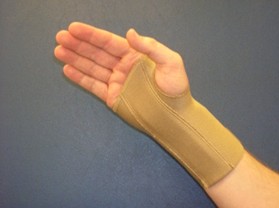
How are wrist splints usually sized?
Wrist splints are usually supplied in small, medium, large or extra-large sizes. The size required is usually based on measuring around the wrist with a tape measure. Different suppliers may use different methods to size so always check.
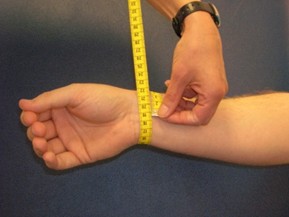
Where do I get a Splint From?
You can order wrist splints online or from a Pharmacy/Chemist. Please check with your local branch.
You can also order from the following companies. Other stockists and suppliers are available.
- Promedics:
- Phone number 01475 746410
- Order online at http://www.promedics.co.uk
- Performance Health:
- Phone 08444 124 331
- Order online at http://performancehealth.co.uk
Thumb Splints
This leaflet gives some advice on buying a thumb splints. The examples in this leaflet are suggestions and will give you an idea of what a thumb splint should look like. These splints cost around £10 for one splint.
Does it have to be a certain design?
Your thumb splint should have an internal bar in it to limit movement at the base of your thumb. It should not limit your thumb tip or finger movement. It should be easy to take on and off. Splints come in two main types.
Thumb splints that only limit thumb movement.
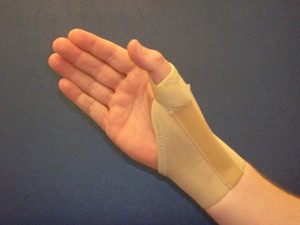
If you need greater support, some splints support the wrist as well.
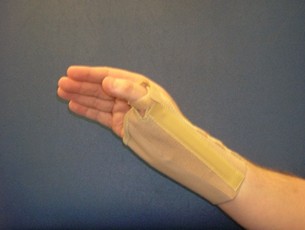
How are thumb splints usually sized?
Thumb splints are usually supplied in small, medium, large or extra large sizes. The size required is usually based on measuring around the wrist with a tape measure. Different suppliers may use different methods to size so always check.
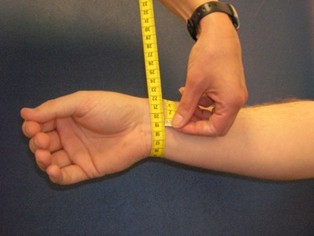
Where do I get a splint from?
You can order wrist splints online or from a Pharmacy/Chemist. Please check with your local branch.
You can also order from the following companies. Other stockists and suppliers are available.
- Promedics
- Phone number 01475 746410
- Order online at http://www.promedics.co.uk
- Performance Health
- Phone number 08444 124 331
- Order online at http://performancehealth.co.uk
When To Speak To A Health Professional
If you have any of the following symptoms please contact your GP.
- If your pain levels, swelling, or colour changes significantly worsen
- If you notice a significant increase in these symptoms affecting other joints
- If you find that early morning stiffness is lasting longer than 30 minutes
- If you are feeling generally unwell (such as fever) in combination with the joint symptoms
Help And Support
If after following the above advice, your symptoms have not improved within 6 to 12 weeks, a referral to a physiotherapist may be beneficial.
You can access physiotherapy by any of the following:
- Completing this online self-referral form
- Speak to your GP about a referral
Additional Information
What do I do if my symptoms flare up?
Flare ups of pain are common. Some people have recurrent flare ups of pain so it is important to know how best to manage these flare ups. In most cases a pain flare-up will settle within 6 weeks.
Top Tips
- You will likely find it helpful to rest a bit more but it is still important to keep active. This will help to avoid becoming stiff and your muscles becoming weak.
- If you aim to get a balance between rest and activity it should help your pain to settle down. You may be sore at first, however, start slowly and gradually increase the amount you do.
- Reduce movements or tasks that aggravate your symptoms. This can help especially in the early days.
- Adopting positions or movements that reduce your pain can be useful.
Acute Injury Management
POLICE is an acronym (Protection, Optimal Loading, Ice, Compression and Elevation) that is used as a management strategy for many injuries and conditions for the first 24 to 72 hours.
- Protection and relative rest are advised immediately after injury for the first 24 to 72 hours.
- Optimal Loading refers to having a balanced rehabilitation program which encourages early and gradual activity to improve recovery. How you progress will vary from person to person depending on the injury. It is about finding the injured areas happy place and increasing slowly and gradually.
- Ice may be used for reducing pain and swelling. There are safety points to follow when you use ice:
- Don’t ice over a numb area or open wound. If the skin is numb you won’t notice if you’re developing an ice burn and ice on an open wound can increase the risk of infection.
- Be wary of ice burns – don’t apply ice directly to the skin, wrap an ice pack in a clean, damp tea towel before applying. Avoid prolonged exposure to ice, 10-20 minutes is usually adequate.
Application of ice
- Apply crushed ice/frozen peas wrapped in a damp towel for 10-20 minutes, 2-3 times per day for the first 5-7 days post injury/ flare up of pain.
- Stop applying ice if there are any negative effects such as increase in pain or swelling or skin soreness.
- Compression and Elevation are helpful for reducing inflammation. This can be done by keeping your joint raised on a pillow and compressed by wrapping a bandage around it.
Do not make the bandage too tight and do not wear tubi-grip or any compression bandage in bed at night. - Heat: After 2-3 days, you may find that heat is more relaxing.
You could use a heat pad or a hot water bottle with an insulated cover on it. Make sure this is not too hot and is not directly touching your skin.
You should do this for 10 to 15 minutes, 3 to 4 times a day.
Pain Relief
Analgesia
- Analgesia also known as pain relief can be an important part in helping you manage your symptoms and allow you to stay active.
- Taking suitable pain relief regularly allows you to move more normally and continue your usual activities without causing any damage. It is unlikely that medication alone will resolve your pain totally. For this reason we are using the term pain relief (A 30-50% reduction in pain would be deemed to be a good success).
Paracetamol
- Paracetamol is a good general pain management medication. It is used to help manage lots of different types of pain.
- Sometimes people believe they need something ‘stronger’ than paracetamol when in fact, taking a regular dose rather than a one-off dose is more effective.
- Spreading the doses of the paracetamol evenly out over a day will help you control your pain. Visit NHS Inform for more detailed information on paracetamol.
Non-Steroidal Anti-Inflammatory Drugs (NSAIDS)
- NSAIDs are medications that can reduce swelling around joints and nerve endings to give pain relief. They are particularly useful in treating inflammatory type pain. Two commonly prescribed NSAIDs are ibuprofen and naproxen.
- Visit NHS Inform for further information related to NSAIDS
There are other forms of pain relievers available. If you feel your current pain relievers are not helping your pain or you are experiencing any side effects from your medication, please seek advice from your GP or pharmacist.
For general information on medication visit NHS Inform.
Staying in work and returning to work
We know that staying in work or returning to work as soon as possible is good for your mental and physical health.
If you have problems with activities at work, it may be helpful to ask for a workstation/workplace assessment or talk with your manager or Occupational Health Department. This can help with alterations or provision of equipment or altering your working day or tasks.
There are organisations which can support you at work or help you return to work. You can ask your physiotherapist or Occupational Therapist for information or visit Knowledge Scotland.
Smoking
Smoking can affect how your body recovers from musculoskeletal problems. If you smoke then the good news is that by stopping smoking it can improve your health in many different ways. Giving up smoking is not something you have to do on your own. You’re twice as likely to stop smoking successfully if you get the right support from the NHS. There is a free NHS stop smoking service available in Lanarkshire to help you succeed.
Chronic Pain
Some people will have pain which persists beyond the expected time frame for their condition. For further information on this and how best to manage it please visit our Chronic Pain webpage.
Pain Association Scotland is a national charity that delivers professionally led self-management pain education in the community.
Active Health Programme
South Lanarkshire
Active Health is a programme for residents of South Lanarkshire living with long term conditions. Residents are referred via Acute, Physio & specialist nurses to a 10-week programme and then signposted onto a wide variety of mainstream physical activity, sport & outdoor opportunities.
South Lanarkshire Leisure and Culture have many active community opportunities as well as specialised referral programmes. Full details of the 20 leisure centres can be found on the SLL website. Contact details across South Lanarkshire or call 01698 476262 to find out the number of your local leisure centre.
Please contact your health professional to discuss this referral or contact SLLC on 01698 476262.
Contact details
- Phone Number: 01698 476 193
- Email: customer.services@southlanarkshireleisure.co.uk
- Address:
- South Lanarkshire Leisure & Culture HQ, First Floor
North Stand, Cadzow Avenue
Hamilton. ML3 0LX
- South Lanarkshire Leisure & Culture HQ, First Floor
-
Website: https://www.slleisureandculture.co.uk/info/34/health_and_fitness
North Lanarkshire
North Lanarkshire Leisure’s Active Health Programme in partnership with NHS Lanarkshire provides a range of supported programmes to help individuals realise the benefits of becoming more physically active whilst also assisting those who are recovering from minor or even more serious illness.
The Active Health Programme has both a General Programme where individuals can access the mainstream health and fitness programmes running within NL Leisure Venues including swimming, jogging, golf and more!
A Specialised Health Class Programme which requires a referral from a health professional, this option is available to individuals who require additional specialised support in taking part in physical activity and classes include Strength and Balance, Cardio I, Cardio II, Back Care and Macmillan Move More classes.
A health and social care professional can make a referral by using the Active Health referral form found at the bottom of the page in the link below.
Contact Details – Health & Wellbeing Information
- Telephone: 01236 341 709
- Email: melanie.menzies@nlleisure.com
- Website: https://www.nlleisure.co.uk/specialised-health-classes/active-health
Mental Well Being
It is very important to look after your own mental wellbeing. This can have an influence on your recovery or management of your Musculoskeletal problem. Visit our mental wellbeing page for more information.
Your Feedback – comments, concerns and complaints
NHS Lanarkshire is committed to improving the service it provides to patients and their families. We therefore want to hear from you about your experience. If you would like to tell us about this please visit our feedback page.

